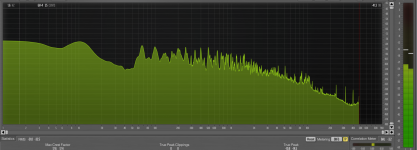True. That's one thing I might tryCorrelation between lf output noise and hv supply noise can not be 100% due to the RIAA shaping and
maybe additional filtering which is probably not shown in the schematic of post 26. There is no useful
supply rejection in a circuit as seen there.
Filament power is tuned to 6.3VDC and is regulated. Very stable.Im not sure it is of any help but the ‘bias’ of the filament power is not mentioned; maybe a black swan.
I'm not sure. @craigtone would know though.Is the circuit with the MOSFET a series regulator or some capacitance multiplier thing? Is it in dropout or working as intended?
Thanks!You might try to "fix" the gate voltage of the HV regulator FET by a suitable electrolytic capacitor. I would add a reverse biased protection diode between G an S in this case. Worth a try.
A good reminder that I need to get some better hookup cables for my final setup with this particular unit when I finish tinkering. I did build myself a little PCB with jumpers for my star ground so I can easily disconnect things or route the chassis connection through a 5ohm resistor (with parallel cap) or bare wire. I also rewired my inputs with shielded microphone cable and tightened up my output twisted pair windings. Will definitely get to other little things like what you're suggesting later when I'm trying to fine tune the overall noise floor.Sure, but every little thing in routing can sometimes add little help.
After all this tinkering and observing on grounded input, I finally put the preamp back to work on a turntable. I noticed that when music is playing that the very large plateau of low frequency noise drops significantly in my FFT (plateau goes down to around -84dB or so instead of sitting at around -40dB or so). Perhaps this is just an artifact of the FFT calculations and what can be perceived when so many other frequencies are dominating the overall picture. Has been a long while since I was studying FFTs and using them hands-on (in a former programming and research life).
In any case, I'll probably set this obsession down for a bit and try to enjoy this thing for a bit before I drive myself crazy. You all have given me some great suggestions for things I could try when I decide to keep digging. For now I probably need a few weeks away from this deep rabbit hole!!!!
That's most peculiar. The FFT is just an algorithm/group of algorithms to calculate a DFT, and a Discrete Fourier Transform is supposed to be linear. What you describe is clearly nonlinear.
Could it be that the music drives the measuring equipment that calculates the FFT into clipping? If so, that could explain it.
Could it be that the music drives the measuring equipment that calculates the FFT into clipping? If so, that could explain it.
I'm not sure, but here's a graph while music is playing. Notice the low frequency shelf isn't sitting so high now.That's most peculiar. The FFT is just an algorithm/group of algorithms to calculate a DFT, and a Discrete Fourier Transform is supposed to be linear. What you describe is clearly nonlinear.
Could it be that the music drives the measuring equipment that calculates the FFT into clipping? If so, that could explain it.
